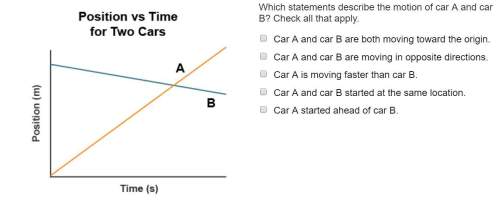
Physics, 14.11.2019 19:31, miguelc2145
Asystem consists of two particles. at t = 0 one particle is at the origin; the other, which has a mass of 0.50 kg, is on the y-axis at y = 6.0 m. at t = 0 the center of mass of the system is on the y-axis at y = 2.4 m. the velocity of the center of mass is given by (0.75 m/s3) t2i^. a)find the total mass of the system b)find the acceleration of the center of mass at any time t. c)find the net external force acting on the system at t = 3.0 s

Answers: 2
Other questions on the subject: Physics

Physics, 21.06.2019 21:40, sannai0415
Since the investigative question has two variables, you need to focus on each one separately. thinking only about the first part of the question, mass, what might be a hypothesis that would illustrate the relationship between mass and kinetic energy? use the format of "if…then…because…” when writing your hypothesis.
Answers: 1

Physics, 22.06.2019 03:00, mmcdaniels46867
Isla’s change in velocity is 30 m/s, and hazel has the same change in velocity. which best explains why they would have different accelerations? isla had negative acceleration, and hazel had positive. isla had a different time than hazel. isla had positive acceleration, and hazel had negative. isla went a farther distance than hazel.
Answers: 1

Physics, 22.06.2019 12:50, stephanie37766
Which changes would result in a decrease in the gravitational force btween two objects? check all that apply
Answers: 1

Physics, 22.06.2019 18:30, TheSpeedster
Two trains leave a station at the same time, train a travels at a constant speed of 16 m/s. train b starts at 8.0 m/s but accelerates constantly at 1.0 m/s squared. after 10.0 seconds, which train has the greater speed?
Answers: 1
Do you know the correct answer?
Asystem consists of two particles. at t = 0 one particle is at the origin; the other, which has a m...
Questions in other subjects:

Mathematics, 19.07.2019 22:00

English, 19.07.2019 22:00

Mathematics, 19.07.2019 22:00


Mathematics, 19.07.2019 22:00

History, 19.07.2019 22:00



Computers and Technology, 19.07.2019 22:00



















